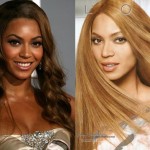Description:
This lesson is a critical examination on photo retouching. It can be used in conjunction with a lesson on teen health, eating disorders, bulimia, anorexia, photo retouching, critical media studies, health and art class.
LESSON PLAN:
Grade: 9-12
Time: 3-5, 50 minute sessions
Introduction:
This lesson introduces students to techniques for photo retouching using Adobe Photoshop. The video tutorial provided above show common techniques used for modifiying an existing photography such as: blemish control, wrinkle removing, color and texture adustmens.
The lesson also asks students and teachers to think critically about the way photo retouching is used in visual media. The video entitled “Photoshop and Ethics” provided above and the images provided can be used as a springboard for a class discussion and for student projects.
California Visual Art Standards:
2.1 Create original artworks in a variety of media that reflect their feelings and point of view.
2.3 Demonstrate in their visual artworks a personal style and an advanced proficiency in communicating an idea, theme or emotion.
2.5 Present a concept in a multimedia artwork that demonstrates knowledge of technology skills (Photosop).
Student Learning Outcomes:
Use Adobe Photoshop to retouch an image.
Adobe Photoshop skills covered: layers palette, layer masking, brush tool, adjustment layers, duplicating layers, blending modes, blur effect
Materials:
1. Computers with Adobe Photoshop installed
2. LCD projector of TV with A/V capabilitiy
3. Internet connection for image searching or collection of images from students or teacher
4. Video tutorials and resources found on http://www.artsandjustice.org/visual-studies-photoshop-ethics-body-image/
SEQUENCE OF INSTRUCTION
DAY 1 – CLASS DISCUSSION/CLASS ACTIVITY
1. Teacher will show examples of photos retouching found in visual culture. Teacher will show the video entitled Photshop and Ethics to class.
2. Teacher will ask students to provide their thoughts about the media shown. Teacher will ask students for any examples of retouching they have encountered in their lives.
3. Teacher will introduce retouching techniques as shown in tutorial video.
4. Teacher will provide project ideas (see list below).
HOMEWORK:
1. Students need to capture (with their phone or camera) or find (google) an image to retouch.
2. Students can start to practice techniques shown in class.
DAY2 – CLASS DISCUSSION/CLASS ACTIVITY
1. Teacher will start by asking students if they had any questions on techniques or concepts covered on the previous day. Teacher will answer questions and review as necessary.
2. Teacher will discuss more retouching techniques.
3. Teacher will inform students that project is due on following session.
HOMEWORK:
1. Students are to continue working on their retouching project.
DAY 3 – CLASS DISCUSSION/CLASS ACTIVITY
1. Teacher will ask students to print, or upload finished projects.
2. Teacher and students will discuss each of the projects. Using critique strategies to discuss the work.
3. Students will back up projects to a hard drive, or cloud storage.
RESOURCES:
1. Photoshop CS “Lesson in a Book”
2. Youtube tutorials on retouching
3. Photoshopping: Altering Images and Our Minds http://www.beautyredefined.net/photoshopping-altering-images-and-our-minds/
4. Beauty Whitewashed: How White Ideals Exclude Woman of Color http://www.beautyredefined.net/beauty-whitewashed-how-white-ideals-exclude-women-of-color/
5. Ethics – definition http://dictionary.reference.com/browse/ethics
6. PBS Kids site on eating disorders http://pbskids.org/itsmylife/body/eatingdisorders/
7. Body Image, Eating Disorders and Obesity in Youth (Book) http://www.apa.org/pubs/books/4317167.aspx
Questions for Discussion:
- What kind of modifications to the human body are possible with retouching?
- How does the use of photo editing distort reality?
- Why is the usage of retouching in media so prevalent?
- What is an eating disorder?
- What is the role of ethics in the realm of photo retouching?
- Can these forms of representation be dangerous to youth?
- Should the media be censored?
- Do you believe there is any correlation between eating disorders such as anorexia and bulimia and images such as these?
Project Ideas:
- Create a video, or 2-D work that shows your knowledge of retouching skills. When you are finished, arrange the finished and original image side by side to compare your results.Save the file in .psd and .jpg format and print or upload your work.
- Create a video or 2-D work that either supports or challenges the use of photo editing in visual media.
- Create a video or 2-D work on the topic of eating disorders.
- Attempt to retouch an image without the use of the computer, using traditional art mediums.
- Write a 1-2 page paper discussing a retouched artwork and your feelings about its effects on society.






